According provided by lens Nikon AF Nikkor 35mm 1: 2D many thanks to Marina Udovitskaya.
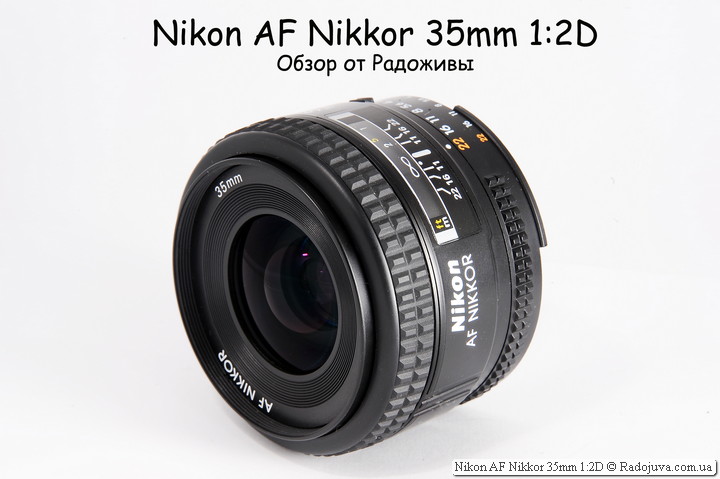
Nikon AF Nikkor 35mm 1: 2D review
Nikon AF Nikkor 35mm 1: 2D is an excellent fast prime for full-frame Nikon FX cameras. The first version of this lens - Nikon AF Nikkor 35mm 1: 2 (no letter 'D', full difference between versions is described here) was released back in 1989, and in 1995 was updated to the D-version. This lens is still being released.
On full-frame cameras, Nikon AF Nikkor 35mm 1: 2D gives a viewing angle of 66 degrees, which allows you to use Nikon AF Nikkor 35mm 1: 2D as a standard lens for many tasks. Often 35 mm focal length is much more convenient than the classic 'fifty'. But on Nikon DX cameras EGF the lens will be almost 53 mm, which greatly affects the ease of use.
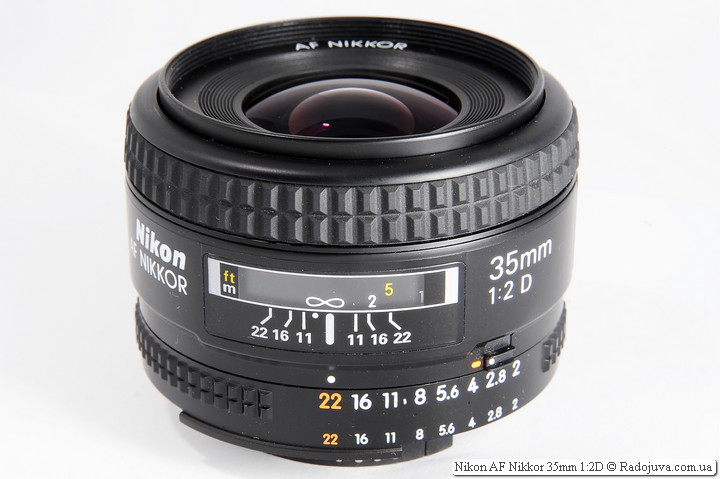
Nikon AF Nikkor 35mm 1: 2D
Nikon AF Nikkor 35mm 1: 2D - very small, weighs just a little more 200 grams and uses 52 mm filters. All Nikon 35/2 lenses are exclusively manufactured in Japan... The build quality is very good. The lens has a metal mount.
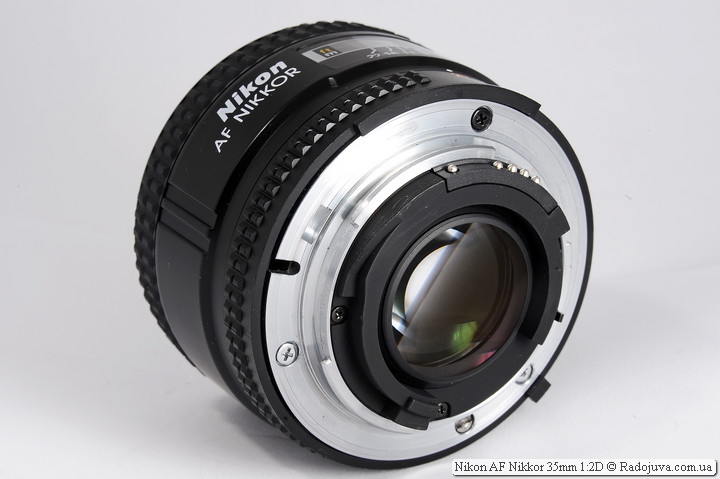
Nikon AF Nikkor 35mm 1: 2D
Nikon AF Nikkor 35mm 1: 2D has aperture control ring. To control the aperture value from the camera, you need to set the aperture ring to F / 22 and fix it with a special button (for more details, see the section on Non-G Lenses).
It's important: auto focus with this lens is available only when using him on cameras with built-in motor focusing.
Exact list Nikon DSLR cameras with a built-in focus motor, on which this lens will focus automatically:
- D1, D1h, D1x, D2x, D2xs, D2h, D2hs
- D3, D3x, D3s, D4, D4s, D5, D6
- Df
- D50, D70, D70s, D80, D90
- D7000, D7100, D7200,D7500
- D100, D200, D300, D300s,D500
- D600, D610, D750, D780
- D700, D800,D800E, D810, D810a, D850
- Fujifilm FinePix S1 Pro, S2 Pro, S3 ProS3 Pro UVIR, S5 ProIS Pro
- Kodak DCS PRO 14n, DCS Pro SLR/n
Exact list Nikon DSLR cameras without a built-in focus motor, on which this lens will not focus automatically:
Only auto focus and sound confirmation of focus will not work with these cameras, all other important functions, such as automatic exposure metering and automatic iris control, will work well.
You will find a lot of useful information on the types of cameras and lenses Nikon here.
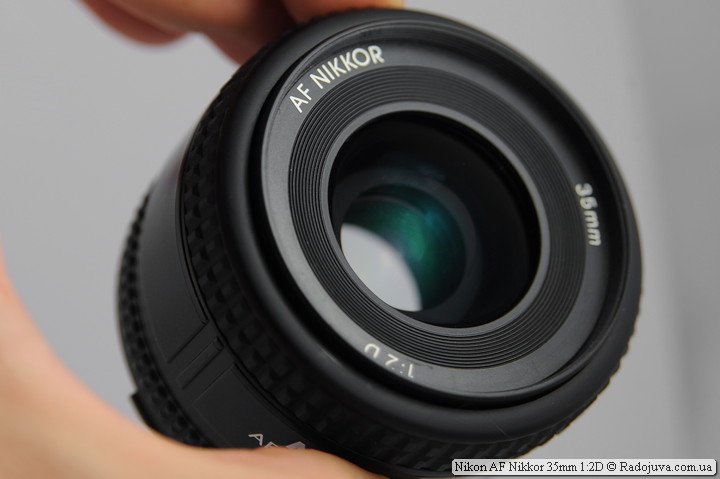
Nikon AF Nikkor 35mm 1: 2D
Lens uses fast auto focus, the speed is comparable to Nikon 50mm 1: 1.8D AF Nikkor... The focus ring is rubberized and rotates approximately 120 degrees. The ring has a hard stop for fast aiming at infinity (a rarity for lenses). When focusing, the front lens does not rotate, but only moves forward. Nikon AF Nikkor 35mm 1: 2D has a very small MDF, which is only 25 cm, while you can get close-up magnification 1: 4.2 - which is very, very good.
During auto focus, the focus ring rotates and cannot be touched. There is no focus mode switch on the lens. To put the lens into manual focus mode and vice versa, use the switch near the camera mount.
In the middle of the lens there is a diaphragm with 7 non-rounded petals, the optical scheme consists of 6 elements in 5 groups. Unlike many modern lenses, Nikon AF Nikkor 35mm 1: 2D does not use special optical elements in its design, but this does not prevent it from creating a good image. The lens has no grooves for installing a bayonet hood, which is why it has to be screwed in place of a light filter.
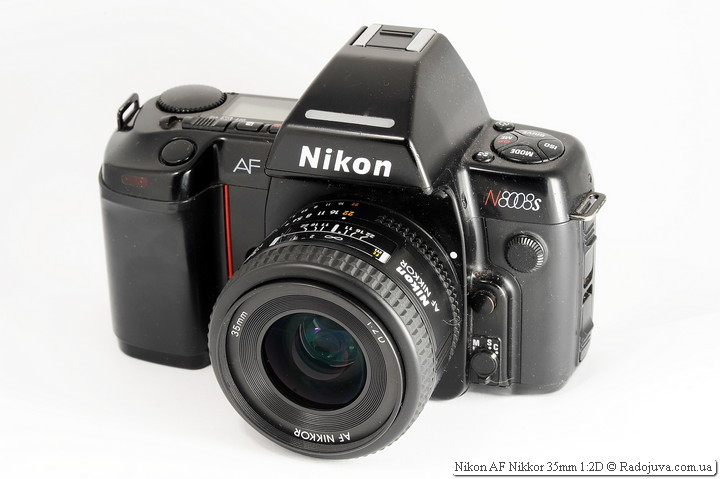
Nikon AF Nikkor 35mm 1: 2D on the ZK
I am often asked the difference between Nikon AF Nikkor 35mm 1: 2D and Nikon AF-S 35mm 1: 1.8G DX Nikkor... In practice, these are two completely different lenses.
- 1: 1.8G is only suitable for Nikon DX cameras, has a built-in focus motor, which allows it to work on the most basic Nikon cameras. The lens is sharper at wide open than '1: 2D'. The lens trunk does not extend when focusing. Continuous manual focus control available in auto mode ''M / A'. Comes with a lens hood.
- 1: 2D is suitable for both Nikon FX and Nikon DX cameras, has an aperture control ring, does not have a built-in focus motor, and therefore it will be difficult to use on Nikon amateur cameras. The distortion level is less than 1: 1.8G. On crop cameras, it gives less noticeable vignetting. Has no mode 'M / A'and hoods included.
The auto focus speed of the lenses is almost the same. For Nikon DX cameras, I recommend buying exactly 1: 1.8G because of better sharpness on the open aperture and a lower price tag.
The parameters shown in the photo gallery:
Everything is filmed on Nikon D700. On-camera JPEG L ('optimal quality' compression), no processing. Functions: vignetting control, ADL, noise reduction at long exposures, noise reduction at high ISOs were turned off. All shot in Picture Control mode SD (standard mode): contrast correction - 0, brightness - 0, saturation - 0, hue - 0, sharpness - position 5 out of 10. Used white balance: 'Auto', 'Fluorescent lights'. The size of the photos was reduced to 3 MP.
It so happened historically that Nikon AF Nikkor 35mm 1: 2D had no native alternatives for a long time - there were only very expensive Nikon AF-S Nikkor 35mm 1: 1.4GN, or old non-autofocus Ai-s, AI, K, OC Auto, OC and O Auto versions. Now this lens has a successor - Nikon ED AF-S Nikkor 35mm 1: 1.8G SWM RF Ashperical. For the price of the closest wide-angle lenses, you can look at Nikon AF Nikkor 28mm 1: 2.8Dor per version Nikon AF Nikkor 35mm 1: 2 MKI. Usually 35mm of focal length are overlapped by some kind of zoom lens, only the zoom will not be able to provide such a high aperture lens :)
In the center of the frame, the lens lacks sharpness at F / 2.0 a bit due to chromatic aberration, but by closing the aperture to F / 2.5-2.8, sharpness immediately returns to normal. In the center of the frame on closed apertures, the lens becomes very very sharp. Also, good sharpness at the edges and corners of the frame starts with F / 8.0. The lens showed a surprisingly small level of distortion, which cannot but rejoice. Easy software on F / 2.0 is not so scary, but in general the lens creates a three-dimensional image with a pleasant neutral color reproduction.
Real prices for the Nikon AF Nikkor 35mm 1: 2D lens in popular online stores can look at this linkor in the price block located below:
Comments on this post do not require registration. Anyone can leave a comment. Many different photographic equipment can be found on AliExpress.
Results
Nikon AF Nikkor 35mm 1: 2D is a good small fix. Interesting fast auto focus, good image quality and small size. I liked the lens very much, it can serve as an excellent standard fixed lens on full-frame cameras or on cropped cameras with a focusing motor.
UPDATE: a cheap similar lens went on sale in 2016 - Yongnuo 35mm 1: 2 (YN35mm F2N, for Nikon cameras, review at this link).
Material prepared Arkady Shapoval. Training/Consultations | Youtube | Facebook | Instagram | Twitter | Telegram

















You write .... But on Nikon DX cameras, the EFR of the lens will be almost 53 mm, which greatly affects the usability of it ... And then say in the next lens 35 mm, 1,8 DX that how effective it is on crop. But even this fully formatted 35 mm will be the same on the crop. Why different opinions about the same focal point on the crop. How will they differ? On the contrary, a full-frame 35 mm will be better since there will be less distortion at the edges.
Just keep an eye on the context.
Arkady, there is a new 35 / 1.G FX, you need to make a change to the text where you write that there are no alternatives other than expensive 1.4, the new 1.8G is about 2 times more expensive than 2.0D and three times cheaper than 1.4.
I bought this lens a couple of weeks ago and only managed to do a thorough test over the weekend. At first I was afraid that there would be soap at f / 2, then I saw it differently. At an open aperture, the lens is soft. For me, this is a plus when I need to photograph people close up - there is no pixel detail on faces, as, for example, on the Tamron 17-50 f / 2.8. At f / 2.2, in my opinion, perfect sharpness is achieved for portraits. At f / 8, you can already shoot landscapes - the sharpness is very good throughout the frame. Many people scold bokeh, but I liked it. I think it's a matter of taste.
Good day. Tell me such a thing! I am looking for a fast lens 30 or 35 mm for crop. I chose either: Nikon AF Nikkor 35mm 1: 2D or Sigma AF 30mm f / 1.4 EX DC HSM. I have a D7000. What do you advise?
C Sigma AF 30mm f / 1.4 EX DC HSM may have problems with back \ front focus, it works fine for me only on D40 and D200, it is impossible to use on D90. Be sure to try my advice at close and long distances, it is better if there is an opportunity to return.
Can you tell me how to cure a slight backlash of the “trunk” on it? Or just ignore it?
Hammer, if shooting does not interfere
I took this glass for 6tr from the wedding man - he had 700, I had 800 - my grid showed the best results - I shoot for the 2nd year…. nipradam nizachto, I shoot weddings at 2.8 - sharp - there is a drawing - I shoot a painting with them and a banquet and ransom .. and in a limousine .. at 2.0 I shoot like candles, the hearth is lit there ... in a wave with downsize up to 12MP - it is certainly noisy to crush).
an example of a portrait on him ...
And one more portrait :)
the best!
spelling dictionary in nightmares do not dream? )))
Would you like to talk about this?
The right eye is almost out of focus)
the flu is quite small, but the hare with a camera was in hand :)
Once again I am convinced that talent is a narrowly focused concept. Whatever talent in photography is that mediocrity in the language.
I can't even imagine how I would find out about lenses, photos, etc. there will be no such site. I use it as a reference. I like very much “my opinion” at the end of each article. Arkady, a huge THANKS!
Good afternoon Arkady I am a regular reader of your wonderful Inceclopedia. Tell me which lens is sharper on FF with f 5.6 35 f2 or 50 1.8G?
Help with the choice of glass for vacation, I take pictures of landscape, landscape + portrait with F 4 and above in clear sunny weather. I am inclined to af 35 f2 d, the sharpness of color reproduction is a priority, will there be a difference in quality with 50 1.8g. D700 camera.
35 / 2D
I bought this glass in Japan, in 2013, when the courses were still normal.
Initially, glass was bought on Nikon D90.
Everything suited the D90 - the picture is sharp and pleasant.
On the same hole, 50 / 1.4D will be softer, IMHO.
I decided to switch to FF - I sold the D90 and bought the much-praised D700.
I put on this glass and ... in general, it would be better not to do this.
The picture is soap soap. I went through all the settings (sharpness, contrast, etc.) and all to no avail.
Instead, the picture acquired airiness and volume.
Some kind of sharpness appeared on the hole 5-5.6. Until f / 4 is a nightmare, especially in the corners.
Everything is decent on 7.1, and better on f / 8, as they wrote before me here.
As a result, it was very profitable to get rid of the D700 on the D3s in excellent condition.
Imagine my surprise when after taking a picture of the brick wall of a nearby house and a park from the balcony of the 8th floor, I noticed that the picture became more decent and sharper and more contrast.
Here I remembered one very peculiar statement that (talking about a carcass!) D700 is good at portraits and macro, and the rest is not very good due to weak pixel sharpness.
I remember how many fray and ridicule it then caused in one famous photo forum.
I specially adjusted all the camera settings as in the D700 and no matter how much I checked, the D3s gave the picture sharper and clearer. Then I managed to change D3c to D4 and somehow I didn't think about “soap”. We managed to compare 35 / 2D with Sigma 35 / 1.4ART. This is heaven and earth. But 35 / 2D has its advantages, which Sigma or even Zeiss will never win: 35 / 2D is very light, almost weightless glass, it is ... more unpretentious and not as sorry for Sigma, 35 / 2D miniature glass and being attached to FF the carcass does not require a huge bag to carry. The 35 / 2D isn't getting as much attention as the Blended Sigma's predatory trunk. Finally, it will never outweigh the carcass. With this glass, there is no movement by 1/20 or even 1/15, from the hands, if the hands are normal.
I have good sharpness on the D700 already at 2.0, and the truth is sharper at the open 50mm f / 1,4D. One resource says that the sharpness of 35 and 2,8 drops, but I didn't notice ...
city landscape with polar
City landscape bw
I noticed that with intense walks with the camera all day and with intensive photography, this glass can throw dust well on the matrix.
Perhaps I have some kind of a copy. But also Japanese assembly and never seems to have fallen. However, yes, this glass is a vacuum cleaner.
Thanks for the review. Given your extensive experience, what would you recommend for Nikon d610. This f2 or f1.8 ff or sigma (art;) thanks!
I’m not Arkady, but I’ll risk writing my thoughts)
It all depends where and how you are going to use it and for what purpose glass is taken.
Sigma ART is best checked for the accuracy of the focus.
I have this glass, it gives a sharp and contrasting picture to stupor, but it’s thoughtful and there are misses of AF. This is not a report glass, IMHO. Then, it is quite heavy and will delay the weight distribution of the camera on itself. Those. light carcass will nod.
35 / 2D frankly, it does not particularly well allow 16MP cameras of the DF / D4 type. The picture is soapy.
But the glass is not afraid of bright light, it quickly and accurately focuses even at night and is still very light.
There is also new and expensive glass - Nikon 35mm f / 1.8G AF-S Nikkor. Sharp and accurate for a 24MP sensor, but suffers from chromaticity at open apertures. I think he also has no problems with accuracy, like 35 / 2D.
There is still a rather sharp Tamron 35 / 1.8 with a stub, but it seems like it costs more than the aforementioned Nikkor 35 / 1.8 under ff.
Thanks, Pokemon. Nikon 35mm 1.8 is not that expensive (relatively), cheaper than sigma and slightly more expensive than f2. I’m hesitating between these two, but it hurts all the reviews of sigma with boiling water, plus they have some kind of dock that will calibrate the lens. Since 35mm will be for outdoor shooting, bokekhe is not particularly necessary and the aperture is not critical, since on the d610 you can calmly shoot on ISO 2000. It is interesting whether there will be a noticeable difference in the picture between nikon f2 and f1.8 if you cover it with 4-8.
from Sigma, those who shoot portraits on it, mostly (and rightly so, I think :)) piss with boiling water. If you are going to shoot with closed apertures, the difference will be minimal (for example, in the “stars” around the lights at night). With the lens from this review, I don't like the rotating focus ring during autofocus operation, and the biggest focus offset in camera settings of all my lenses (about -18). Otherwise, the lens is good, small, light, at F / 2,8 you can fully work, at an open aperture - a little soft. Cheap polarizing filters, again). Below in one picture are two frames (center of the frame, D800), on the left - at F / 2.0, on the right - at F / 2.8. Sharpening and a clear decrease in CA are also clearly visible. If you close the aperture down to 7.1, then on D800 the lens shows excellent sharpness in landscapes. I bought mine used as a store, for $ 200, so the difference in price between the rest of the options can be significant.
Thank you, Yuri! Really on f2 terrible aberrations. Now I am scratching turnips, because I have a Nikon 35-70 f2.8, maybe it is 35mm and not inferior? Although the fix is of course important not only in the quality of the picture, but also in saving time on playing the zoom instead of focusing on the composition. Maybe then Nikon 28mm 2.8d can handle the role of street fix. Cheap and cheerful :)
My instance of 35 / 2D on the aperture 2.0 gives a lot of focusing errors and I almost never use it. For landscapes, I use 7.1-9.0.
35 / 1.8G gives much worse chromatic aberration than 35 / 2D on open apertures, but it seems to me to give a sharper picture on covered apertures. I read opinions that Nikon created 35 / 2D at the time as a fast and accurate reportage fix just for reportage work in any lighting conditions. Therefore, against the background of new glasses, now it looks a little strange, because in many ways it loses to them optically, but nevertheless, Nikon does not remove it from production and still produces it in Japan along with expensive premium glasses.
Hello everybody. D7200 is available and there is Nikon DX AF-S Nikkor 35mm 1: 1.8G.
it is possible to take a Nikon AF Nikkor 100mm 35: 1D for 2 euros. Does it make sense or is it not worth it?
I do not see the point in this.
If it’s not a secret, where can I get it for such a price? I’m just looking for this instance.
I want to ask Arkady, or knowledgeable people. What does the last letter D on the Nikon AF Nikkor 35mm 1: 2D lens mean? I have exactly the same lens, but without the letter D.
Response here и here... In short - marking, which means that the lens can transmit focusing distance values to the camera.
Thank you Arkady !!!
Arkady, tell me if you compare Nikon 35 f2.0 and 35 f 2,0 on a full-format camera (nickname d 750), which lens should I prefer? I tend to be young. Thanks.
I would be inclined to the old man of Nikon, a more stable focus result, a more reliable construct. YN is more suitable as a replacement for Nikon 35 1.8DX for cameras without a focus motor.
One question has long tormented me - I had a D90, then a D700.
A question about 35/2D (and not only) - why on D90, let's say, at aperture 5.6 and shutter speed, let's say 1/50, ISO 800-1200, and on D700, despite the LARGE size of the matrix, with the same or compressed to 6.3 aperture and shutter speed, the ISO is almost always HIGHER in the same conditions and with the same camera settings, for example, exposure meter settings. It would seem that the matrix on the D700 is physically 2.25 times larger, the pixel is thicker, the glass opens completely, but then why is the ISO always required for the camera to set higher and never lower? And so on many glasses.
I love handheld street photography in the dark - sometimes I manage to catch something unusual or a beautiful play of shadow and light.
On different crop with the same lens in different conditions the cameras set different parameters. I think this is due to the features of the exposure meter of each camera model. This is hardly related to the full frame.
You can answer in different ways. The simple answer is that the lens aperture does not change from crop to full frame. A more complex answer is that the luminous flux per unit area is the same (if we neglect vignetting), so there should be no difference in exposure per crop or full frame.
Arkady, thanks! But still I can’t understand.
The fact is that about ten thousand handheld shots were taken on the D90 in such conditions, and I could roughly predict what ISO and exposure in the dark the camera with 35 / 2D would offer me. Shot in A mode - aperture priority. On the D700 with the same shutter speeds and aperture, I thought the ISO would be less - full frame, the same. But nifiga, everything is the other way around, the ISO camera is in the same mode after the “blue hour”, i.e. always higher in the dark - 1600-2000. Another problem is that the glass is soapy, and if on the crop the corners and edges were not so noticeable due to the crop factor, then on the D700, not only is the picture more soapy, but also the diaphragm wants to be pressed more, yes, alas, nowhere - endurance and ISO grow nowhere to go - a lot of marriage. Those. a strange situation, as if the D700 is "darker" or something. I cannot formulate. For me - the matrix is larger, there is more light, the ISO is less and the shutter speed should be shorter on the same glass.
Check out ADL, it happens very often because of it. If the picture is more soapy in general, then most likely there is a catch somewhere.
And there and there ADL was always off.
You need to make sure that when the ISO values differ on the D90 and D700, the resulting frames are the same. If the frames are exposed differently (with the D90 it is darker than with the D700), then nothing prevents you from making corrections to the D700 and achieving the same result as you liked on the D90. Well, in general: shoot in raw, then refine. Even at ISO 1600-2000 with the D700 you can get good shots.
And that too :)
Iso of specific cameras does not always correspond to the reference value of photosensitivity. The difference can sometimes be very significant. Hence, different exposure lenses.
I plan to buy a D610 camera, I want to choose 35 glass, tell me which one to choose Nikkor 35mm 1: 2D or Nikkor 35mm 1: 8G?
The third option is to look towards Sigma - which model?
I shoot mostly people / portraits, landscapes sooo rare.
Take 35 1.8G FX. From Sigma worthy of Sigma 35 / 1.4 ART
In general, a list of all autofocus 35 currents for Nikon can be found here.
The D300S camera. Confused from above in a question.
Sigma AF 30mm f / 1.4 EX DC HSM.
Or is it still Nikkor 35 1.8G DX?
These are both crop lenses.
These are both crop lenses. I have already indicated what to take.
and fotik like crop
Nikon D610 belongs to the class FX camera. List and Details here.
Nikkor is optically better, and you have to decide what is best for you. Arkady's opinion (possibly outdated) here https://radojuva.com/2012/07/obzor-sigma-af-30mm-f1-4-ex-dc-hsm/
Does the difference between Nikkor 35mm 1: 2D and Mir-24n really feel?
I read that the world is losing contrast in the backlight, but in sharpness?
Hello! Please tell me if you compare this lens with another 35mm lens, but for crop DX sensors (DX AF-S Nikkor 35mm 1: 1.8G). I am interested in the viewing angle and perspective, it should be the same on both glasses, right? And here and there the EGF will be about 50mm (35 * 1.5)? Or are there any differences due to design differences in DX lenses?
It will be the same.
thanks for the answer! Then, if possible, it makes sense to invest more in FX lenses, which are for a full frame. So to speak "for growth." DX is certainly more affordable in terms of prices, but in the case of an evolutionary transition to a camera with a “full” frame, they will turn into a pumpkin, and lenses for FX will be in use and will play even better on a “full” matrix.
Alternatives for the money with such aperture, simply do not exist. Creative lens, my favorite.